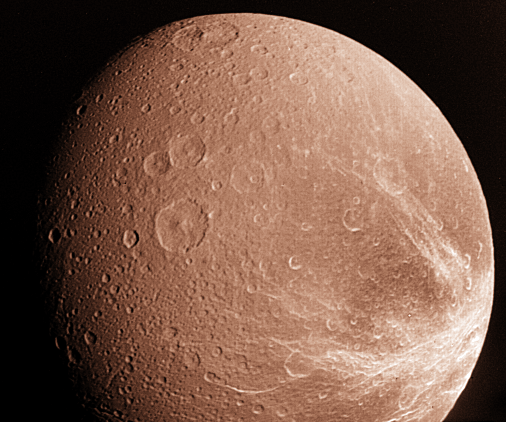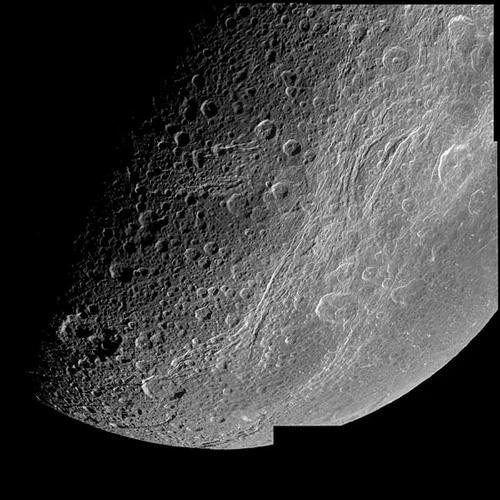

Dione:
Dione was discovered in 1684. It is an icy body with a density of 1.43 gm/cm3, which makes it the densest moon of Saturn other than Titan.
Dione is probably composed of a rocky core making up one-third of the moon's mass, with the rest water-ice. Dione's icy surface includes heavily cratered terrain, moderately cratered plains, lightly cratered plains, and wispy material. The heavily cratered terrain has numerous craters greater than 100 kilometers in diameter. The plains area tends to have craters less than 30 kilometers in diameter. Some of the plains are heavily cratered while others are not.
Much of the heavily cratered terrain is located on the trailing hemisphere, with the less cratered plains area existing on the leading hemisphere. This is opposite from what some scientists expected. A cratering model was proposed for a tidally locked satellite with the highest cratering rates on the leading hemisphere and the lowest on the trailing hemisphere. This suggests that during the period of heavy bombardment, Dione was tidally locked to Saturn in the opposite orientation.
Why is it backwards today? Because Dione is relatively small moon and an impact causing a 35 kilometer crater could have spun the satellite around. Since there are many craters larger than 35 kilometers, Dione could have been repeatedly spun during the early cratering era. Dione has probably been tidally locked in its current position for the past several billion years.
This theory is also supported by observations of the brightess of Dione, where the average surface albedo decreases from the leading to the trailing hemispheres (The leading hemisphere is brighter). This is due to a higher micrometeor dusting on the leading hemisphere, where small impacts polish the surface to give it a higher albedo.
Also seen on Dione's surface are long, wispy features. The origin of the bright wispy material is somewhat obscure. Apparently, it is material with a high albedo, but is thin enough that it doesn't obscure the surface feature underneath. It might have formed from eruptions of water and sulfur along cracks in Dione's surface that fell back to the surface as snow or ash.

This very detailed image taken during the Cassini spacecraft's closest approach to Saturn's moon Dione on Dec. 14, 2004 is centered on the wispy terrain of the moon. To the surprise of Cassini imaging scientists, the wispy terrain does not consist of thick ice deposits, but rather the bright ice cliffs created by tectonic fractures.